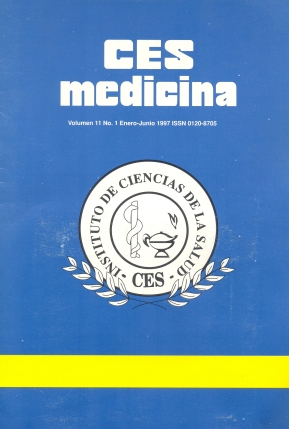UTILIDAD DEL SOPORTE EN FASE LUTEA CON OVULOS DE PROGESTERONA EN INSEMINACION ARTIFICIAL INTRAUTERINA HOMOLOGA. PROFAMILIA-IN SER. 1996-1997
Resumen
Se determinó la utilidad de la administración de los óvulos de progesterona vaginal, como soporte de fase lútea en las pacientes sometidas a inseminación artificial homóloga intrauterina; se cuantificaron los valores de progesterona sérica, efectos colaterales y número de gestaciones en dos grupos, de los cuales uno recibió óvulos de progesterona 100 mg cada 12 horas y el otro no. Se estudiaron 65 parejas distribuidas en 74 ciclos durante 6 meses (junio - diciembre de 1996 ), a las cuales se les realizó estimulación ovárica controlada, seguimiento folicular por Ecografía Transvaginal, inseminación artificial homóloga y soporte de fase lútea, en Profamilia e In Ser (Clínica del Prado) Medellín. Se encontró que los dos grupos con óvulos (45) y sin óvulos (29) eran similares en cuanto edad, número de ciclos, número de folículos, indicación de la inseminación, tipo de infertilidad y dosis utilizada. Se presentaron más gestaciones en aquellas pacientes que utilizaron óvulos de progesterona, 11.1% por ciclo, versus 3.4 % por ciclo en aquellas que no utilizaron soporte de fase lútea (p= 0.57). Se halló un aumento significativo de la progesterona sérica el día 21 y 23 del ciclo, luego de administrar óvulos de progesterona intravaginales (200 mg/día por 15 días), en promedio de 44.3 ng/dl +/- 23.9 para el día 21 y 46.4 ng/dl +/- 27.6 para el dia 23. Mientras que en aquellas pacientes que no utilizaron óvulos el valor el día 21 del ciclo fue de 27.5 ng/dl +/- 12.5 y el día 23 del ciclo fue de 20.68 ng/dl +/- 10.7. Se encontro una diferencia significativa en los valores de progesterona del día 21 (p= 0.0008) y del día 23 ( p= 0.000007), entre las pacientes que recibieron o no óvulos de progesterona. Al realizar el delta de progesterona sérica entre del día 21 y 23 en las pacientes que recibieron los óvulos de progesterona, se presentó una tendencia al aumento en los niveles; mientras en las pacientes que no tuvieron soporte de fase con los óvulos, el valor de la progesterona permaneció constante o la tendencia fue a disminuir (p= 0.008). El efecto colateral mas frecuente en las pacientes que utilizaron los óvulos de progesterona, fue el disconfort vulvar en 9 pacientes ( 20% ), siguiéndole en su orden hidrorrea ( 4.4%). No se presentaron alteraciones en los valores séricos de la progesterona en relación a la absorción. Los anteriores hallazgos permiten sugerir la conveniencia del soporte de fase lútea en pacientes sometidas a inseminación artificial homóloga intrauterina, debido a que se observó un aumento en los niveles de progesterona sérico, con pocos efectos colaterales y mejores tasas de gestación luego de la administración de óvulos de progesterona intravaginales.
SUMMARY
It was determined the utility of the use of vaginal progesterone ovules, to support the luteal phase in pacients submit to intrauterine homolg artificially insemination and to wantificate the levels of seric progesterone, secundary effects and the number of pregnancys in two groups, one of the received progesterone ovules 100 mgr q 12 h and the other not. Seventy four cicles were studied during six months (June-December 1996) this patients were treated with folicular follow up with transvaginal echography, homologal artificial insemination and the support of the luteal phase in Profamilia and in In-Ser (Clinica del Prado - Medellin). It was found that the two groups [with ovules (45) and without ovules (29)] were similar according to the age, number of cycles, number of follicles, the indication, tipe of infertility and the quantity. There were more pregnancies in the pacients that recived progesterone ovules, 11.1% for cicle vs 3.4% for cicle in the others that did not recived ovules. P=0.57 It was found a significant increase in the seric progesterone in the day 21 and 23 of the cicle after the use of intravaginal progesterone ovules (200 mgs/day during 15 days) in average of 44.3 ng/dl and 46.4 ng/dl ± 27.6 respectively. While in the pacients that didint we progesterone ovules the value of the day 21 of the cicle was 27.5 ng/dl ± 12.5 and in the day 23 of the cicle was 20.68 ng/dl ±10.7. There is an stadistically significant difference in the values of progesterone of the day 21 (p less than 0.05) and of the day 23 (p less than 0.05) between the pacients that recived or not progesterone ovules. The colateral efects more common in the pacients that recived progesterone ovules was vulvar disconfort in 9 pacients (26%), follow up of hydrorrea (4.4%). Upon carrying out the delta of the seric progesterone between the day 21 and 23 in the patients that recived progesterone ovules, there was a tendency to the increase in the progesterone, while as in the patients that didint received progesterone ovules, the levels of seric progesterone remain constant or to decrease (p=0.008). The anterior findings permint to sugest the convinience of the support of the luteal phase in pacients with intrauterine himologal artificial fertilitation because an increase in the seric level, of progesterone, with low colateral effects, and with better rates of pregnancies after the use of the intravaginal progesterone ovules.
Descargas
Descargas
Publicado
Cómo citar
Número
Sección
Licencia
Derechos de reproducción (copyright)
Cada manuscrito se acompañará de una declaración en la que se especifique que los materiales son inéditos, que no han sido publicados anteriormente en formato impreso o electrónico y que no se presentarán a ningún otro medio antes de conocer la decisión de la revista. En todo caso, cualquier publicación anterior, sea en forma impresa o electrónica, deberá darse a conocer a la redacción por escrito.
Plagios, duplicaciones totales o parciales, traduccones del original a otro idioma son de responsabilidad exclusiva de los autores el envío.
Los autores adjuntarán una declaración firmada indicando que, si el manuscrito se acepta para su publicación, los derechos de reproducción son propiedad exclusiva de la Revista CES Medicina.
Se solicita a los autores que proporcionen la información completa acerca de cualquier beca o subvención recibida de una entidad comercial u otro grupo con intereses privados, u otro organismo, para costear parcial o totalmente el trabajo en que se basa el artículo.
Los autores tienen la responsabilidad de obtener los permisos necesarios para reproducir cualquier material protegido por derechos de reproducción. El manuscrito se acompañará de la carta original que otorgue ese permiso y en ella debe especificarse con exactitud el número del cuadro o figura o el texto exacto que se citará y cómo se usará, así como la referencia bibliográfica completa.
| Estadísticas de artículo | |
|---|---|
| Vistas de resúmenes | |
| Vistas de PDF | |
| Descargas de PDF | |
| Vistas de HTML | |
| Otras vistas | |



